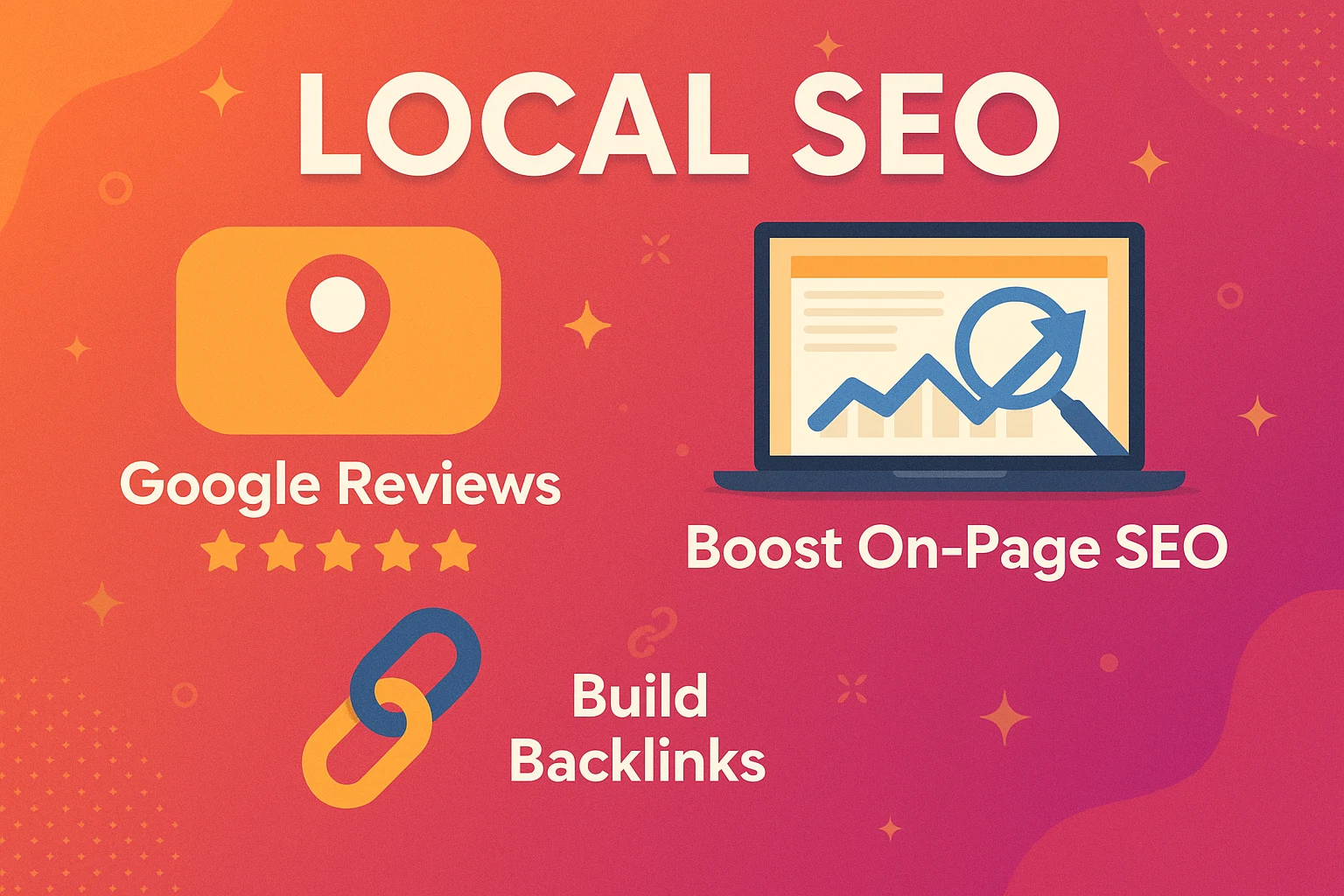Unlock Local Success: Your Guide to Local SEO

What is Local SEO?
Local SEO helps search engines understand where your business is, what you do, and how reliable you are. It focuses on improving how your business shows up in free, location-based search results—like those on Google Search and Maps.
This strategy is ideal for businesses with a physical location (like dentists, salons, or cafes) or ones that serve a specific area (like plumbers, tutors, or electricians). A strong local SEO plan brings more traffic, leads, and sales from people nearby who are ready to buy.
- Google Reviews
- Build Backlinks
- Boost On-Page SEO
Local SEO vs. Standard SEO
Here’s how local SEO differs from general SEO:
| Aspect | Details |
|---|---|
| Target Audience |
Standard SEO: Targets a broad audience across cities, states, or countries. Local SEO: Focuses on people near your business or within a specific area. |
| Ranking Focus |
Standard SEO: Uses content, backlinks, and technical setup. Local SEO: Uses local signals like Google Business Profile (GBP), reviews, and NAP. |
| Key Area to Optimize |
Standard SEO: Website pages and link building. Local SEO: GBP, reviews, and directory listings. |
| Search Results Display |
Standard SEO: Blue link results. Local SEO: Map Pack (with pins and ratings) + blue link results. |
What Affects Local SEO Rankings?
Google looks at three key things:
- Relevance: Does your business match the search?
- Distance: How close is your business to the searcher?
- Prominence: How well-known is your business?
Other important factors:
- Google Business Profile (GBP): Seen as the top factor for Map Pack rankings.
- Reviews: More and better reviews help you rank higher.
- Backlinks: Links from other sites show your authority.
- On-Page SEO: Optimized pages boost rankings.
- NAP Citations: Keep your Name, Address, and Phone the same across platforms.
- Keywords in GBP and Reviews: Help Google understand your services.
- Review Sentiment: Positive words matter.
- Check-ins & Social Shares: Add to your online presence.
- Google Maps Ratings: Stars directly impact rankings.
How Local SEO Works
When a search has “local intent,” Google uses different rules than standard SEO. It shows two types of results:
- Map Pack: A box at the top with a map and 3 local listings.
- Organic Results: The regular links below the map.
To rank well, Google must understand:
- Where you are
- What you offer
- If people trust your business
Key Actions for Local SEO
- Set up and optimize your Google Business Profile.
- Get more reviews and reply to all of them.
- Make sure your NAP info is consistent across the web.
- Research and target local keywords.
- Build strong, relevant backlinks.
- Improve on-page SEO with local terms.
- Keep your details up to date.
- Use local SEO tools to track your progress.
Step-by-Step: How to Do Local SEO
1. Set Up & Optimize Your Google Business Profile (GBP)
- Verify & complete all fields: Add hours, photos, services, and contact info.
- Choose the right category: This affects what searches you appear in.
- Add good photos: People love seeing inside your business.
- Keep info consistent: Don’t mix “Street” and “St.”—stick to one.
- Stay active: Update your profile with news, offers, and events.
2. Get More Reviews (And Respond)
- Ask happy customers: Use signs, texts, or emails to ask for reviews.
- Focus on Google: GBP reviews have the biggest SEO impact.
- Reply to all reviews: Shows you care. Builds trust.
- Don’t pay for reviews: It breaks Google’s rules.
3. List Your Business in Directories
- Audit your current listings: Tools like Semrush can help.
- Fix wrong info: Inconsistent NAP is bad for rankings.
- Submit to big and local directories: Use platforms like Yelp, Bing Places, Apple Maps, and Facebook.
- Look for niche sites: Industry and local directories work best.
4. Do Local Keyword Research
- List your services: Think “AC repair,” “root canal,” etc.
- Use keyword tools: Try Ahrefs or Google Keyword Planner.
- Check Google results: If a map shows, it’s a local keyword.
- Think voice search: Use natural phrases like “best pizza near me.”
- Assign keywords: One page per service or area.
5. Build Backlinks
- Partner with local businesses: Ask for links from their websites.
- Join your Chamber of Commerce: It gives you a link and exposure.
- Sponsor events: Often gets your name and link on event sites.
- Pitch local stories: Announce events or milestones to local media.
- Reclaim lost links: Redirect old URLs to current pages.
- Spy on competitors: See who links to them but not to you.
6. Boost On-Page SEO
- Use local keywords in headers and meta titles: Put the city or area first.
- Show your NAP on the site: Add to contact page and footer.
- Create city pages: Write custom content for each location you serve.
- Add schema markup: Helps search engines understand your business.
- Embed a map: Shows your exact location to users and Google.
- Write for users: Answer common local questions on your pages.
Let's talk about your project
Call the best Freelance Local SEO expert in Kochi, Kerala to grow your business visibility, attract local customers, and achieve higher Google rankings.
Tools



